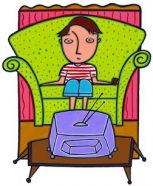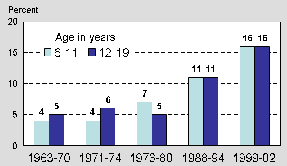Packing Fat
Even among kids, waistlines are bulging, and many people are worried about the trend.
By Emily Sohn
The world is getting bigger—not the planet itself, but many of the people in it.
In developed parts of the world, from Australia to Europe to the United States, waistlines are bulging. People weigh more than ever before. Even children are joining the ranks of the obese in record numbers, and scientists are concerned.
 |
|
Do you consider yourself to be overweight? If you do, you’re not alone.
|
“It’s pretty obvious we have a problem here,” says Ross Brownson. He’s an epidemiologist at the St. Louis University School of Public Health in Missouri. “Most people would agree we have an epidemic,” he says.
Stopping the obesity epidemic is one of Brownson’s major goals. And he’s not alone.
As part of the Institute of Medicine’s Committee on Prevention of Obesity in Children and Youth, Brownson is one of 19 experts in the United States who recently released a report called “Preventing Childhood Obesity: Health in the Balance.”
The report proposes ways to keep the nation’s youth from getting fatter and fatter. The best solution, the experts say, is to get parents, schools, communities, governments, and kids themselves involved in tackling the problem together.
More than pudgy
Many people can be a little pudgy around the tummy or the seat, but obesity is much more serious than that.
To see if someone is seriously overweight, doctors use a mathematical formula that takes a person’s height and weight and spits out a number called the Body Mass Index (BMI). They then compare the person’s BMI to those on a special chart.
In adults, a BMI between 18.5 and 25 is normal, greater than 25 is overweight, and greater than 30 is obese. An adult who is 5 feet, 5 inches tall, for instance, would have to weigh 150 pounds to be overweight and 180 pounds to be obese.
Childhood obesity is a little different. For one thing, age makes a difference. So does whether the child is a boy or a girl. To be considered obese, a kid has to be in the top 5 percent of the BMI chart for his or her age.
According to the new report, some 9 million children in the United States over the age of 6 now qualify as obese. Over the last 10 years, obesity has become more than twice as common in children between the ages of 2 and 5 and in young people between the ages of 12 and 19. In the 6-to-11-year-old set, the rate has more than tripled.
Health concerns
It isn’t just that being overweight might make it harder for you to drag yourself out of bed or off a couch. Obesity can cause serious health problems.
 |
|
Snack foods, such as sodas and french fries, can contribute to obesity in kids.
|
Studies show that weighing too much as an adult can lead to a variety of illnesses, including breast cancer, arthritis, and heart disease. Diabetes is a big one, too.
Diabetes makes it hard for the body to process sugar. It can develop in one of two ways. Some people are born with what’s called “juvenile” (or type 1) diabetes, and their symptoms start in childhood. A second kind, often called “adult-onset” or type 2 diabetes, has traditionally tended to occur in obese adults.
With the spread of obesity to younger people, though, type 2 diabetes has followed.
“Over a 10-year period, studies show a 10-fold increase in the risk for diabetes in children,” Brownson says. “We never used to see it in kids. Now, we’re seeing . . . adult-onset diabetes in teenagers and even younger children.”
Treating all these health problems is getting mighty expensive. Between 1997 and 1999, obesity-related hospital costs for kids averaged $127 million a year, up from $35 million a year between 1979 and 1981.
If the obesity epidemic continues at its current pace, Brownson says, today’s obese kids will cost the country an estimated $11 billion in the future.
There are other costs, too. People who are overweight often face a world that is unkind to them, and teasing can really take its toll. Depression and low self-esteem are common among obese people.
And the trend toward fat can be hard to break. Obese parents tend to have obese children. And obese kids tend to become obese adults.
Diet and exercise
So, how do you know if you’re in danger of becoming obese?
Stepping on the scale won’t necessarily give you an answer. Some people are naturally heavier than others, and that’s okay.
Also, Brownson says, an overweight athlete is actually healthier than a thin couch potato. Muscle weighs more than fat and can skew the measurements.
To find out whether you should be concerned, it’s best to talk to a doctor or school nurse, who can tell you more about how your weight fits in with the weight of others in your age group.
It can also help to learn more about the causes of obesity so that you can spot danger signs in yourself.
People put on pounds when they take in far more calories than they use up. If you don’t exercise enough and eat a lot of fatty or sugary foods, you could be in trouble.
Studies show that kids are watching more TV, playing more video games, and spending more time using the Internet than they used to. Many schools have cut their physical education programs. And few kids are walking or biking to school anymore. This means more time sitting and less time getting exercise.
 |
|
Spending more time watching TV means less time exercising.
|
“There’s been a steady increase in how much time people spend in their cars,” Brownson says.
At the same time, people are eating more and more. Portion sizes in restaurants have grown over the years, and most people can’t help but eat more when there’s more food in front of them.
Super-sizing is a bad choice when it comes to watching your weight. And sugary drinks may be part of the problem.
“Twenty years ago, we didn’t have Big Gulps,” Brownson says. “The standard soda size was 8 or 10 ounces. Today, it’s 20 ounces. That’s a lot of calories to keep track of.”
Resisting the urge
Resisting the urge to indulge can be difficult, especially with the messages that pummel kids all day long. Everywhere you look, commercials, billboards, even scenes in movies try to persuade kids to buy junk food and sugary drinks.
The average child gets up to 40,000 hits of advertising and promotion every year, Brownson says. “If you’ve ever watched cartoons on Saturday morning,” he says, you’d have seen that “they’re not advertising a lot of fruits and vegetables.”
To fight such pressure, Brownson says, kids can try to imagine what kinds of commercials they would design to spread the word about the dangers of obesity.
The new report calls on local governments to make their cities and towns more “kid-friendly” with better bike paths, sidewalks, and playgrounds, and safer streets. It urges kids to spend less than 2 hours a day with computers and TVs so that they can spend more time running around. It asks schools to make physical activity a priority during the day. And it encourages families to eat well and do more activities together, including something as simple as after-dinner walks.
It helps kids a lot if parents set a good example. Parents influence what their kids eat. “You can’t have parents saying one thing and doing something else,” Brownson says.
Fighting obesity is a big job, but not a lost cause, Brownson says, as long as everyone works together.
“We have to be in this for the long haul,” he says. “We’ve taken decades to get into this mess. It’s going to take decades to get out.”
In the meantime, watch out for all those Halloween candies! They may be scarier than you think.
Going Deeper:
Fat Facts
The following chart shows how the percentage of children who are overweight has increased since 1963. The chart gives information about children in two different age groups (6 to 11 and 12 to 19) in the United States.
 |
Source: Centers for Disease Control and Prevention
Comments:
My friend and I agree very much with your article. Now we can tell other people and make a change. THANK YOU!!!!!!!—Farzana, 12







